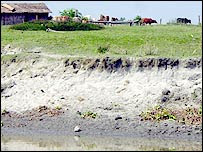ON MAJULI ACTION PLAN, Dilip K. Medhi
A convention of the 22 Satras, Village Councils, NGOs and the local government will be held to form a team as major stakeholders besides others.
Majuli receives more than 1,000,000 domestic tourists and more than 500 overseas tourists every year and a token tax would be collected from them. The Satras will begin to raise fund for the action plan through hosting of cultural functions in the island and outside, particularly in the different Metros of the mainland India. Moreover publicity will be conducted through Internet, broachers and booklets. Problems and opportunities of all these tourists and supporting infrastructure as shown become the problems and needs of the heritage conservation.
All indigenous vocations like silk, particularly the golden silk, textiles, mask making, pottery industry and gold ornaments will be made more attractive to the tourists.
The heritage culture tourism concept is going to upgrade the Satriya cultural heritage of Majuli, to educate the local people and Bhakats (devotees), to preserve and document the culture of the traditional ritual songs, dances, dramas and to preserve the customs and the indigenous lifestyle, and to protect the potential natural resources.
Living religious establishment and associated arts as tourism attractions
Step 1. – Review draft mission statement
Mission statement
Continuity of education
To implement the entry fee to Majuli
Establishment of potential resources
Development strategy
Improvement and promotion of arts and culture
Role of cultural heritage (religious practices, e.g. Drama, music, dance, literature)
Step 2. – Identify flagship action in each of the four model areas
Model 1 – Fiscal management
Principle: contribution from the Satras, NGOs, local government to the conservation programme
Action area:
Fund raising activities together with the annual activities ? short term
Establishment of the locally managed heritage fund
Model 2 – Investment
Principle:
Short term: user pays as principle
Long term: infrastructure standard
Action area
Short term:
Improvement of existing guest houses
Improvement of transportation
Improve local indigenous craft product
Long term
Model 3 – Employment
Principle: community education
Action area: improve vocational skill
Model 4 – Consensus building - not yet
Step 3. – Model the flow
Step 4. – Model relationship between stakeholders and actors
Identify stakeholders according to the 3 cathegories:
Tangible, eg. Arts, cratfs
Intangible: eg. Satras
Environmental heritage
THE MODEL IS A PROCESS TO BE BUILT IN
Wednesday, August 8, 2007
M A J U L I
Majuli: Island in the Sun
Majuli, the largest river island in the world, is a civil sub-division of Jorhat District. It is located 20 km. off Jorhat town (Asom, India). It is a pollution free fresh water island. Total area of the island was 1250 sq.km., now it is about 650 sq.km.Its length from east to west is about 90 km. & width from north to south is avg. 16 km. Majuli is a natural & cultural heritage site. With water bodies covering most of the areas , Majuli attracts plenty of birds both local & migratory. About 25—26 Satras are remaining now in Majuli of which the Satras of Kamalabari, Auniati & Garmur are worth mentioning. These Satras are propagating the religious ideology of great Assamese medieval Vaisnavite Saint Sankardeva & Madhavdeva, preaching Satria culture.
Majuli, the largest river island in the world, is a civil sub-division of Jorhat District. It is located 20 km. off Jorhat town (Asom, India). It is a pollution free fresh water island. Total area of the island was 1250 sq.km., now it is about 650 sq.km.Its length from east to west is about 90 km. & width from north to south is avg. 16 km. Majuli is a natural & cultural heritage site. With water bodies covering most of the areas , Majuli attracts plenty of birds both local & migratory. About 25—26 Satras are remaining now in Majuli of which the Satras of Kamalabari, Auniati & Garmur are worth mentioning. These Satras are propagating the religious ideology of great Assamese medieval Vaisnavite Saint Sankardeva & Madhavdeva, preaching Satria culture.
The Satras :The Vaishnava Satras were founded by Sankardeva, the father of Assamese culture. The historic and auspicious 'Manikanchan Sanjog' was the first Satra in Majuli. Subsequently 65 satras grew which propagated the ethnic and sociocultural ideals. At present there are only 22 Satras in Majuli and rest have been shifted to other safer places due to flood and erosion. These Satras are the treasure house of 'Borgeet', Matiakhara, Jumora dance, Chali dance, Noyua dance, Nande Vringee, Sutradhar, Ozapali, Apsara dance, Satria Krishna dance, Dasavater dance etc. which were contributed by Shri Sankardeva.
Majuli is the world’s biggest riverine island and a principal place of pilgrimage for the Vaishnavites of Assam since the Ahom days. There are several Satras of Vaishnava religious creed. Of these holy seats, Auniati, Daksinpath, Garamur and Kamlabari are the four most prominent. What is of special importance is its satra establishment, consisting of separate structures, built for different purposes.
Friday, August 3, 2007
Subscribe to:
Posts (Atom)



